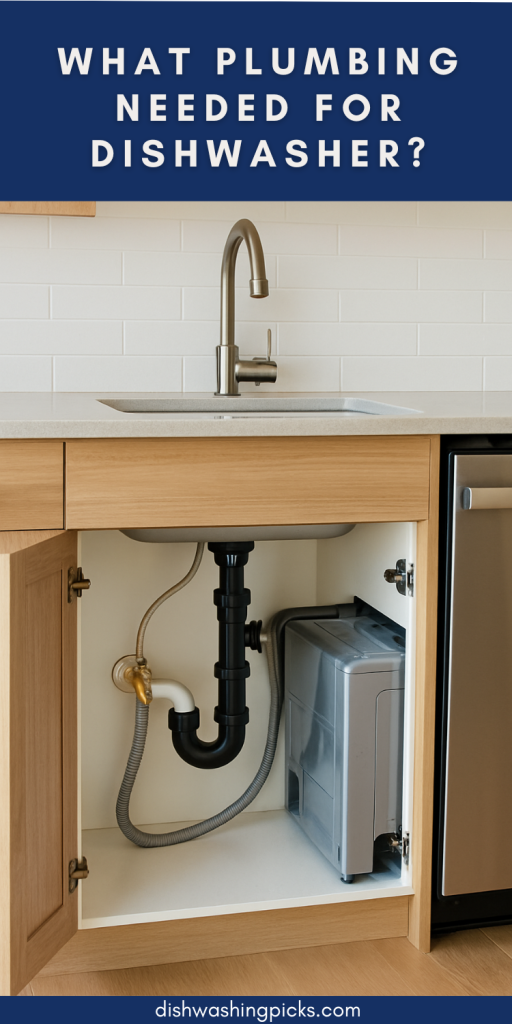
So, You’re Thinking of Installing a Dishwasher?
Installing a dishwasher can feel like a big deal, but once you break down what you need, it’s totally doable! You’re probably wondering, “What plumbing do I actually need for my dishwasher to work?” Well, great question! Whether you’re upgrading your kitchen or finally getting rid of those hand-washing dishes, knowing the right plumbing setup is key.
In this guide, we’ll walk you through everything you need to know about the plumbing that supports your dishwasher—from water supply to drainage and beyond. Stick with me, and you’ll be ready to tackle this kitchen upgrade like a pro!
The Water Supply – Getting Water to the Dishwasher
Okay, let’s start with the basics. Your dishwasher needs a good water supply, right? But where does that water come from?
The Water Line Connection: Your dishwasher will need to be connected to the hot water line. Yep, that’s the line you typically use for sinks, showers, and baths. The hot water valve, which is usually located under the kitchen sink, is where you’ll hook up the water line. The dishwasher’s water supply line typically comes with a flexible hose that you can connect to this valve.
What’s the Ideal Pressure? Now, here’s something to think about: the water pressure needs to be at least 20 psi to ensure your dishwasher runs properly. Too little pressure, and it’ll leave you with dirty dishes (and a lot of frustration). So, be sure your plumbing can support this!
Drainage – Where Does All That Water Go?
So, your dishwasher’s done cleaning, and now it’s time to get rid of all that dirty water. But how does it know where to go?
The Drain Hose: Your dishwasher has a drain hose that connects to the sink’s drain or garbage disposal. This is where the dirty water will flow out. Make sure the hose is securely attached and doesn’t have any kinks. Kinks can cause water to back up, and nobody wants that!
High Loop: Here’s something you might not know. Dishwashers have something called a “high loop” for the drain hose. Essentially, the hose is raised under the counter before it’s hooked into the drain. This little trick prevents dirty water from flowing back into the dishwasher, which can keep your dishes cleaner.
Electrical Connection – Powering the Dishwasher
Okay, this one’s more electrical than plumbing, but let’s briefly touch on it because it’s just as important. You’ll need a nearby power outlet for your dishwasher to work. Typically, dishwashers require 120 volts, and it’s often wired directly into the electrical system. Some older models might require a hard-wired connection, while others have a plug that connects to a regular outlet.
Should You Hire an Electrician? If you’re not familiar with electrical work, it might be a good idea to call in a pro. You don’t want to risk anything here. Trust me, it’s better to be safe than sorry.
Other Considerations – The Sneaky Details You Might Forget
Now that we’ve covered the big plumbing aspects, there are a few other things to keep in mind:
- Dishwasher Height and Space: Before you start installing, check that your dishwasher will fit properly in the designated space. Measure the height, width, and depth to avoid headaches later.
- Water Filtration: Some people like to install a water filtration system that connects to the dishwasher’s water line to improve water quality and protect the dishwasher from hard water deposits. If you have hard water, this might be a good option!
Ready to Go?
So, there you have it! You need a hot water supply, a good drainage system, a solid electrical connection, and a little elbow grease. With the right plumbing setup, you’ll be enjoying clean dishes in no time without the endless scrubbing.
But, if plumbing and electrical work feel like a little too much to tackle on your own, don’t hesitate to bring in a pro. They can make sure everything’s hooked up and working properly, so you can focus on just loading the dishwasher. Ready to make life easier? Let’s get that dishwasher installed!
